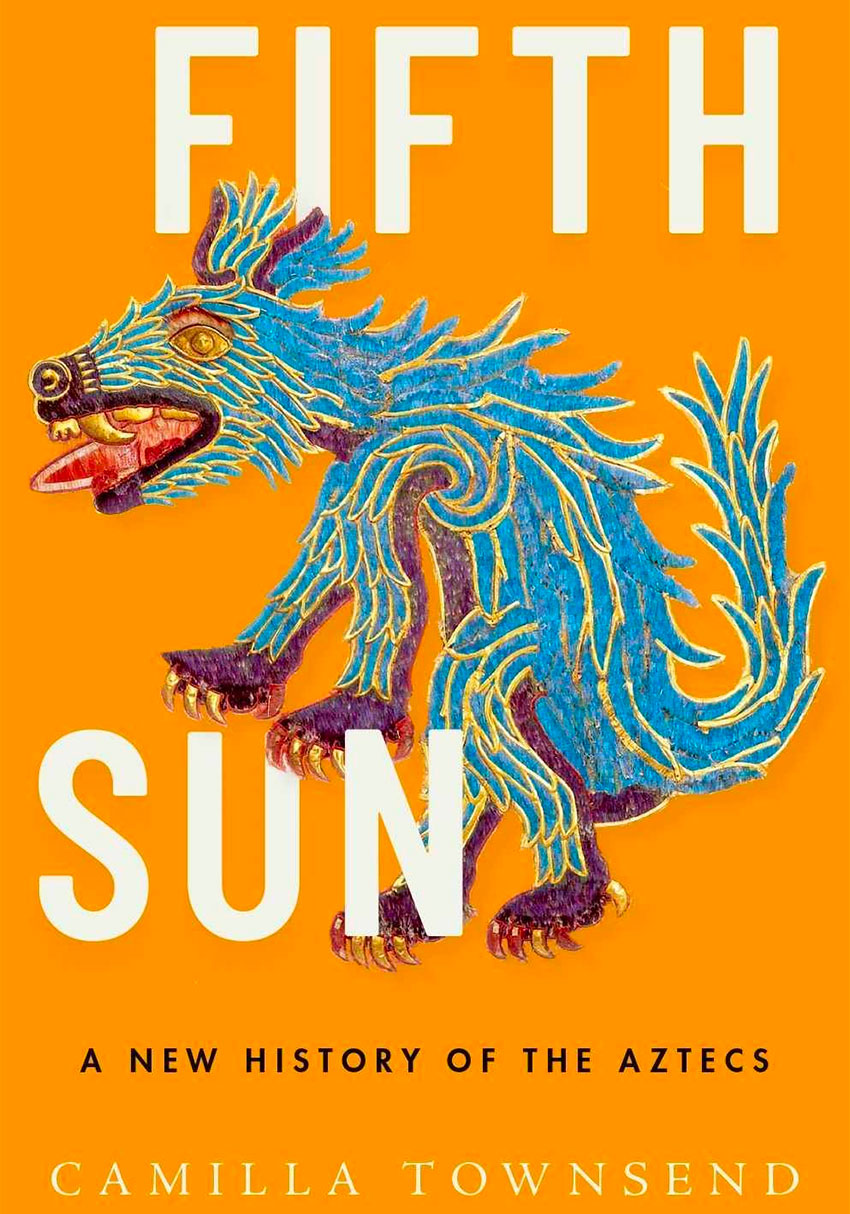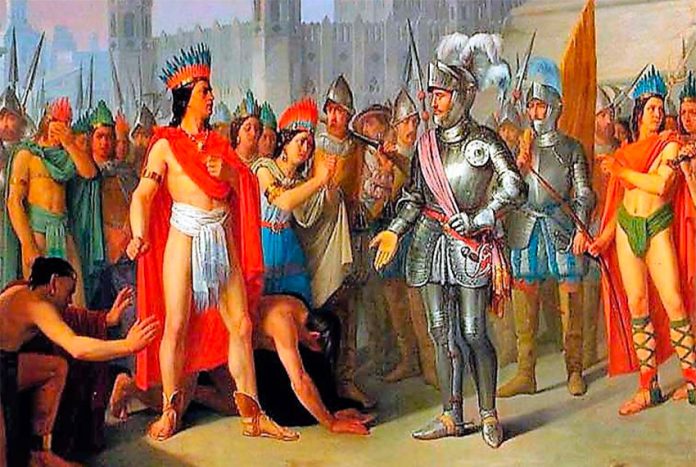Five hundred years after the Aztec empire made its first fateful contact with the Spanish conquistadors, a new book examines the Aztecs through their own lens instead of that of the Spaniards.
Fifth Sun: A New History of the Aztecs by Camilla Townsend draws upon the expertise of its author, a Rutgers University professor long interested in the Aztec language Náhuatl.
“I really, really wanted Nahua sources,” Townsend said in a phone interview. “I just wanted to try to tell the story, really, the way the Nahuas did.”
According to the book, it is the first history of the Aztecs based exclusively upon histories they wrote following the Spanish conquest. Known as the annals, they were written using the Roman alphabet, with the 17th-century chronicler Don Domingo Chimalpahin compiling the most. Unlike the well-known Florentine Codex, the Spaniards were unaware of the Aztec annals, which Townsend calls “written-down history by Nahua for Nahua children.”
Townsend uses the annals to convey a narrative of the Aztecs that differs from conventional perceptions. She holds that they were not uniformly bloodthirsty in warfare or religion, and that they did not lose their empire out of a view that the Spaniards were gods, or because emperor Moctezuma II lost his nerve against conquistador Hernán Cortés. And she holds that the Aztec story did not end with the conquest.

“I really wanted to create a sense that life continued,” she said. “I don’t mean that it was unchanged.” However, she added, “They did survive. They may have felt it was the end of all things. But they managed. They held themselves together.”
One way the Aztecs survived after the conquest was by compiling annals of their history in their native language. And, Townsend said, “there are patterns … They’re not all so different.”
Townsend’s interest in Náhuatl began in 1998. A professor at Colgate University at the time, she decided to enroll in a summer course in the ancient language at Yale. “I thought because it was an indigenous language, it would be much harder,” she said. Instead, she realized, “language is language. All have a subject, predicate, verbal declension.”
She had not realized “how many sources there are in Náhuatl,” she reflected. “I said, ‘My God, I must do this.’ The last 20, 22 years, it’s what I have been doing.”
Townsend has used her expertise to write multiple books about Aztec history, such as the 2006 Malintzin’s Choices: An Indian Woman in the Conquest of Mexico. She continues to explore the role of Malintzin, commonly known as La Malinche, an indigenous woman who played a key role as Cortes’ translator during the Aztec conquest. Townsend also wrote the acclaimed 2016 work The Annals of Native America: How the Nahuas of Colonial Mexico Kept Their History Alive.
For Fifth Sun, Townsend said, “the last few years, when I ended up writing the book, I needed to be familiar with a lot of annals.” She contrasted her comprehensive approach with that of academia in general, which she characterizes as an atmosphere of specialization. “There’s no sense how much of the histories really have in common with each other,” she said.

As she was focusing on the annals, she questioned long-cited Spanish sources from the centuries of conquest, including friars Bernardino de Sahagún and Diego Durán. She also said she gave little attention to previous “famous scholars” of the Aztecs.
Townsend described the book as approaching the project in her own way. “It’s not a lack of respect,” she said. “I just wanted to try telling the story, really, the way the Nahua did.”
According to Townsend, the annals collectively provide an overview of Aztec life as early as 50 to 60 years before the conquest. “Beyond that, it’s fuzzy,” she said.
She investigates the rise of the empire of the Mexica, centered at Tenochtitlán, amid numerous neighboring altepetls, or city-states. These altepetls were governed by polygamous chieftains or tlatoanis, some of whom were related by marriage. One arguably less familiar figure mentioned in the book is Nezahualcóyotl, the 15th-century tlatoani of Texcoco, father of an estimated 117 children.
The Mexica worshiped a pantheon of gods — including the rain deity Tlaloc, whose influence Townsend sees as lingering decades beyond the conquest. Their priests took captives in battle. Yet even in the early history of the Mexica, Townsend disputes established accounts of brutality.
To her, their Flower Wars are more of an Olympic-style ceremony than bloody combat, and as for their reputedly extensive practice of human sacrifice, “I don’t think they were sacrificing thousands of people a day,” she said. However, she added, “Don’t get me wrong. It may seem they got a little out of control in the end.”
When Cortés and the Spaniards landed on the Mexican coast in 1519, Moctezuma II had been emperor for 17 years. Townsend likened the emperor’s situation to that of Western leaders today in the midst of the coronavirus crisis. She sensed resolve in Moctezuma. “I had no sense he just fell apart, nor does the evidence seem to indicate it,” she said.
However, she notes, there were “thousands more Spaniards, hundreds more ships.” And Cortés had encountered an indigenous woman named Malintzin whose knowledge of language proved invaluable.
“She was not an Aztec,” Townsend explained. “Her people were attacked by the Aztecs. She was sold into slavery because of her coastal area fighting with the Aztecs. It would have made no sense for her to side with the Aztecs.” As Townsend noted, “she was a prisoner of the Spaniards. She had to figure out how to stay alive, how to keep a lot of other people alive.”
With Malintzin translating, Moctezuma and Cortés met for the first time on the causeway between Iztapalapan and Tenochtitlán on November 8, 1519. This scene is recreated in vivid detail by Townsend, as well as the tumultuous events of the next two years — the imprisonment and death of Moctezuma; the initial expulsion of the Spaniards from Tenochtitlán; their subsequent return and victory amid an outbreak of disease that decimated the Aztecs, with their last emperor, Cuauhtemoc, captured and eventually executed by Cortés.
The conquering Spaniards attempted to erase Aztec culture through baptism, Christianity and educating indigenous boys in the Spanish language. Malintzin, as well as Isabel-Tecuichpotzin, Moctezuma’s daughter and Cuahtemoc’s widow, both “married Spaniards and their children became Spanish grandees,” Townsend said.
Both women also had children with Cortés. Townsend chronicles the post-conquest life of Martín Cortés, the son of Hernán Cortés and Malintzin, who became a Spanish nobleman, but was accused of treason. In 1568, in the wake of unrest between the Spaniards and Aztecs, he was tortured to death.
In a wider story of death over the decades, epidemics continued to ravage the indigenous population. These outbreaks continued “roughly every 20 years,” Townsend said, beginning with a “horrific disease” in 1520-21 and continuing into the early 1600s.
In a footnote she writes that the diseases diminished the population “by almost two-thirds” over time. “Each generation was smaller,” she said. “Women had fewer babies.”
“There were new waves, new diseases,” Townsend said. “It was a very similar crisis to the one today, Covid-19.”
And yet, even in their darkest moments, the Aztecs did not forget their old ways, she said, citing the example of the chronicler Chimalpahin. Educated by the Spaniards and working in a church, Chimalpahin nevertheless found inspiration from his ancestral religion when disease struck again. Townsend said that the iterations he used when writing about “all the people bowed with illness” are reminiscent of “the old prayer to Tlaloc.”
“His way of prayer was probably influenced by the way his parents and grandparents prayed,” Townsend said. “In a cultural sense, there was less of a conquest than first thought.”
• Fifth Sun is available for purchase on Amazon.
Rich Tenorio is a frequent contributor to Mexico News Daily.
